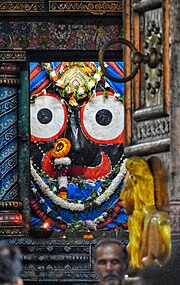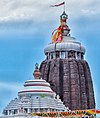Dhanasri
Today, Dhanasri is a topic that fascinates people of all ages and backgrounds. Whether due to its historical relevance, its current influence or simply its ability to surprise and entertain, Dhanasri has become a point of interest for a wide audience. In this article, we will explore in depth different aspects related to Dhanasri, from its impact on society to its evolution over time. We will be addressing different perspectives and opinions to offer a complete and enriching vision of this fascinating topic.
| Odia script | ଧନାଶ୍ରୀ |
|---|---|
| Melā | Dhanasri |
| Jati | Oudaba - Sampurna |
| Badi | Panchama |
| Sambadi | Sadaja |
| Anga Ragas | Mangala Dhanasri |
| Allied Ragas | Gundakiri |
Dhanasri (Odia: ଧନାଶ୍ରୀ, romanized: dhanāsri) is a rāga belonging to the tradition of Odissi music.[1][2][3] Falling under the meḷa of the same name,[4] the raga uses komala gandhara and komala nisada swaras and is traditionally associated with the karuṇa rasa.[5] The raga is mentioned in treatises such as the Gita Prakasa[6] and Sangita Narayana.[7][5]
Structure
An ancient raga, Dhanasri is accepted as one of the primary melas in Odissi music due to its prominence. It has been used by hundreds of poet-composers for well-over the past many centuries.[8] Its aroha-abaroha are given below :
Aroha : n S g M P n S
Abaroha : S n D P M g R S
| Oṛiśī Sangīta |
| Odissi music |
|---|
 |
| Composers |
| Shāstras |
| Compositions |
| Instruments |
Compositions
Some of the well-known traditional compositions in this raga include :
- Sariba Ki E Nisi Go by Banamali Dasa[9]
- Kanta Bina Diba Rajani by Upendra Bhanja
- Kadamba Bane Bansi Bajila by Gopalakrusna Pattanayaka[10]
- Gostha Chandramanku Asa by Gopalakrusna Pattanayaka[10]
- Ke Ki Kahi Ki Bigidaila by Gopalakrusna Pattanayaka[10]
- Kunchita Nila Kuntala by Benudhara
References
- ^ Panda, Pt. Gopal Chandra (2004). Odisi Raga Ratnabali ओडिसी राग रत्नावली (in Hindi). Bhubaneswar. OCLC 225908458.
{{cite book}}: CS1 maint: location missing publisher (link) - ^ Parhi, Dr. Kirtan Narayan (2017). The Classicality of Orissi Music. India: Maxcurious Publications Pvt. Ltd. p. 383. ISBN 9788193215128.
- ^ Hota, Dr. Damodar (2012). Udra Paddhatiya Sangita (in Odia). Vol. 2. Bhubaneswar: Swara-Ranga. pp. 18–19.
- ^ Odisi Raga Sarani. Bhubaneswar: Odissi Research Centre. 2004.
- ^ a b Misra, Purusottama (2009). Bose, Prof. Mandakranta (ed.). Sangitanarayana (A Seventeenth Century Text on Music and Dance from Orissa). Indira Gandhi National Centre for the Arts and Motilal Banarsidass Publishers Pvt. Ltd. ISBN 9788120832886.
- ^ Badajena Mahapatra, Krusnadasa (1983). Panigrahi, Nilamadhab (ed.). Geeta Prakash. Bhubaneswar: Odisha Sangeet Natak Akademi.
- ^ Deva, Gajapati Narayana (1966). Acharya, Pt. Banambara; Patnaik, Kabichandra Dr. Kali Charan; Mohapatra, Kedarnath (eds.). Sangita Narayana. Bhubaneswar: Odisha Sangeet Natak Akademi.
- ^ Das, Ramhari (2004). Odissi Sangeetara Parampara O Prayoga ଓଡ଼ିଶୀ ସଙ୍ଗୀତର ପରମ୍ପରା ଓ ପ୍ରୟୋଗ [The tradition and method of Odissi music] (in Odia). Bhubaneswar, Odisha: Kaishikee Prakashani.
- ^ Dasa, Banamali (1934). Dasa Goswami, Babaji Baishnaba Charana (ed.). Banamali Padyabali (in Odia). Cuttack: Arunodaya Pustakalaya.
- ^ a b c Pattanayaka, Gopalakrusna (2002). Behera, Dr. Krushna Charan (ed.). Gopalakrusna Rachanabali (in Odia). Gopalpur, Cuttack: Sahitya Sangraha Prakasana.
